Welcome to our Deer Resistant plant list for Central Texas. Of course, there are NO GUARANTEES! Every location has its own “deer pressure” and the best way to see what works in your area is to observe what plants are not being eaten!
We recommend spraying ALL new plants, whether they are “deer resistant” or not, with Deer Out repellant twice a week for about three weeks after planting. Deer will sample anything new, and at certain times of the year or in a drought situation, NOTHING is reliable.
Please read all comments. Some plants are “deer tolerant”, meaning that they may be browsed on the new growth but not completely eaten. (Free pruning!) Others may only have the flowers eaten, as in Red Yucca. Again, look for what is working in your area and go from there. Plant tags and labels are not reliable in all areas in regard to deer resistance.
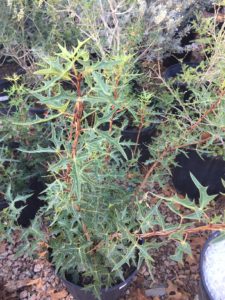
Agarita Mahonia trifoliata
3′-6′ x 4′-6′
Sun/Part Sun/Shade
Evergreen
Yellow flowers and edible red berries. Attracts pollinators and wildlife. May be shaped lightly in the early spring. Zone 6

Agave species
sizes vary by variety
Sun/Part Sun
Check hardiness zone. Some species may produce offsets. Main plant dies after bloom but offsets may be replanted. Bucks (deer) may damage plants during the rut with their antlers. Very drought resistant once established. Requires well-drained soil. Zones vary by variety

Ajuga Ajuga reptans (assorted varieties)
6″ x 1′
Shade/Dappled Shade
Evergreen to herbaceous perennial. Will come back from roots.
Blue flowers appear in the spring. Protect when young, as deer may pull it up to try it and drop it elsewhere. Requires well drained organic soil and regular irrigation. Zone 3

Angel’s Trumpet Datura wrightii
4′ x 4′
Sun
Perennial to re-seeding annual. All parts are toxic to humans and animals. White flowers appear from spring to frost. Seed pods are large and spiny. Double flowered varieties are less winter-hardy. Zone 8
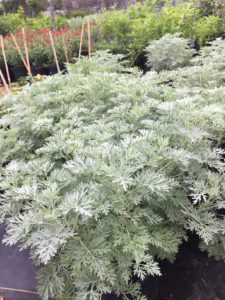
Artemesia Powis Castle Artemesia x ‘Powis Castle’
2′ x 4′-6′
Sun/Part Sun
Evergreen to partly evergreen. Silvery foliage gives good contrast in the landscape. Fragrant foliage. May be cut back in late February to early March. Zone 4
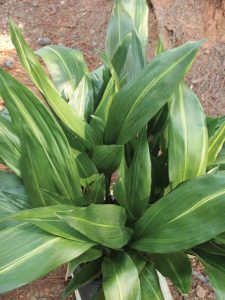
Cast Iron Plant Aspidistra elatior
3′ x 3′
Shade/NO SUN
Evergreen to mostly evergreen. Remove older brown leaves in late February to early March. Zone 7
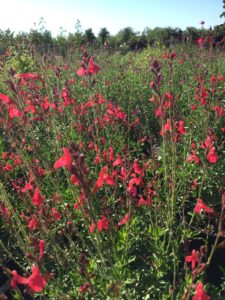
Autumn Sage Salvia greggii
3′-4′ x 3′-4′ for most varieties
Sun/Part Sun, requires at least 6 hours of direct sun
Evergreen perennial
Prune after bloom in the summer, can make a severe prune in late Feb/early March. After 3-5 years, if it is very woody you can do a “rejuvenative pruning” in late winter, cutting back to 6″. Zone 7
Spray with repellent when first planted if deer pressure is high.
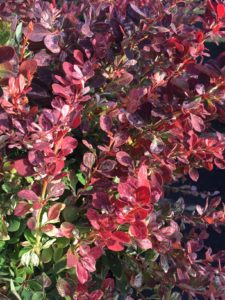
Barberry Berberis thunbergii
Size varies by variety
Part Sun- afternoon shade preferred
Deciduous shrub
Requires well drained soil. Plant has thorns and sometimes red berries. Leaves are green, red or orange, depending on variety. Zone 4
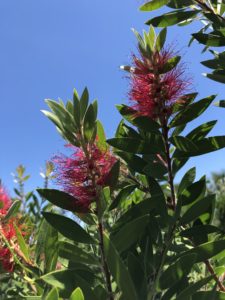
Bottlebrush, Woodlander’s Hardy Callistemon sp.
4′-5′ x 4′-5′
Sun
Evergreen shrub
Red bottlebrush-shaped flowers appear spring through frost. This is the only Bottlebrush that is reliable winter-hardy in Zone 8. May be sheared between blooms. Zone 7
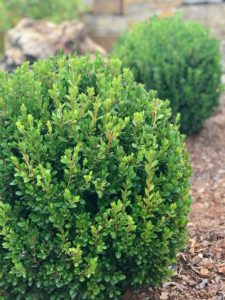
Boxwood, various Buxus species
size varies by variety
Sun/Part Sun/Dappled Shade
Evergreen shrub
Slow growing. Available in many different mature sizes. May be sheared. Zone 4
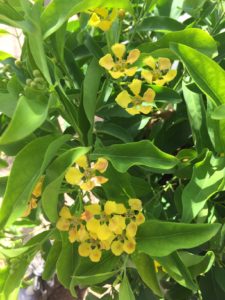
Butterfly Vine, yellow Mascagnia macroptera
10′-12′ vine, may be invasive with runners on the ground
Sun/Part Sun
Evergreen most winters. May lose leaves or die back in severe cold in Zone 8. Yellow flowers in the summer are followed by light brown seed pods that resemble butterflies. Zone 8
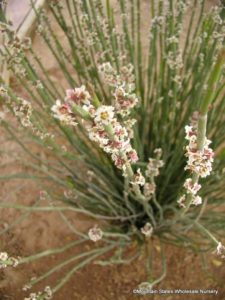
Candelillia/Wax Plant Euphorbia antisyphilitica
1.5′ x 3′
Full Sun/Part Sun
Evergreen most winters. Protect in extreme cold.
Drought resistant plant that adds texture to the landscape. Use with other drought resistant plants in well drained soil. Zone 8
Photo courtesy of Mountain States Wholesale Nursery

Catmint, Walker’s Low Calamintha sp.
1′ x 3′
Sun/Part Sun
Evergreen most winters. Will return from roots.
Fragrant mounding perennial with blue blooms. Fairly drought tolerant. Zone 4
 Cholla, Tree Cylindropuntia imbricata
Cholla, Tree Cylindropuntia imbricata
3′-9′ x 3′-6′
Full Sun
Evergreen
Hot pink blooms in spring. Very winter hardy. Easy to root from cuttings. Zone 5

Coral Bean, Giant Erythrina x bidwillii
10′ x 10′
Full Sun
Herbaceous, will come back from stump
Red “fireman’s cap” flowers all summer long. Susceptible to Erythrina cane borers. Zone 7b

Coral Bean, Native Erythrina herbacea
6′ x 6′
Sun/Part Sun
Herbaceous shrub
This native Coral Bean sends up tall spiky flower stalks in late spring, followed by thorny branches. Although it dies to the ground in Zone 8 it comes back reliably each year. Hummingbird magnet. Zone 8
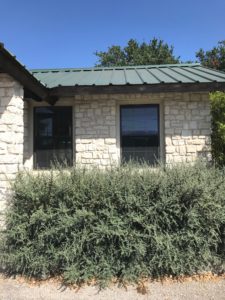
Cotoneaster, Grayleaf Cotoneaster glaucophylla (pronounced coh-TOE-nee-as-ter)
4′-6′ x 4′-6′
Full Sun/Half Sun
Evergreen
May be sheared to keep smaller or to shape. “Deer tolerant”-deer may eat new growth. Spray with repellent when first planted until you learn of the deer pressure Zone 7

Daisy, Copper Canyon Tagetes lemonii
4′ x 4′
Full Sun
Herbaceous perennial Oils from plant may cause skin irritation in hot weather.
May have light bloom in spring but main flowering time is fall. Plant with Gulf Muhly and Mexican Bush Sage for a fall show! Zone 8
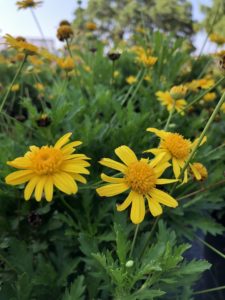
Daisy, Euryops Euryops pectinatus
3′ x 3′
Full Sun/Half Sun
Tender Perennial. Not reliable winter hardy.
Tons of summer blooms cover this plant. Does well in pots. Zone 9b

Damianita Chrysactinia mexicana
1′ x 1′
Full Sun
Evergreen
Small mounding woody perennial. Blooms in spring and fall. May be “ponytailed” and pruned into green growth but does not send new growth from woody stems. Prune in late winter before new growth begins and again after bloom. Zone8
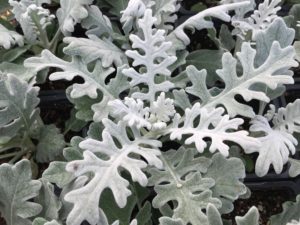 Dusty Miller Senecio cinereria
Dusty Miller Senecio cinereria
1′ x 1′
Sun/Half Sun
Evergreen
Silver leaved perennial with yellow blooms. Prune after blooms finish. Makes a nice border plant. Zone 8
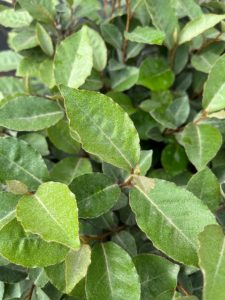
Elaeagnus Silverberry Elaeagnus spp.
Size depends on variety
Sun
Evergreen
Dwarf variety ‘Glen St. Mary’ stays under 4′. Eleagnus ebbengii may grow to 8′. Eleagnus pungens has thorns. Plants produce a small edible berry. Flowers are fragrant. Deer may browse new growth. Has a tendency to put out long shoots that may be pruned. Plants tolerate pruning. Zone6b
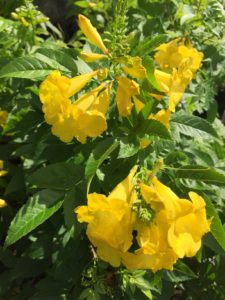
Esperanza/Yellow Bells Tecoma stans varieties
Size depends on variety, Many colors now available
Sun
Herbaceous perennial. Cut back to the ground in late February/early March. Late to return in the spring so be patient until it gets really hot!
Zone 8-11, depending on variety
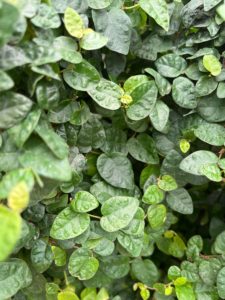
Fig, Creeping Ficus pumila
3″-6″ x 20’+ Will crawl up walls and attach with “holdfasts”. Do not plant on wood walls or stucco walls or the holdfast roots will attach and pull off pieces of the wall when removed.
Sun/Part Sun/Shade
Semi-evergreen. May die to the ground in severe winters, and will need to be removed from walls. Usually comes back from roots. May be sheared on the wall to keep it contained. Zone8
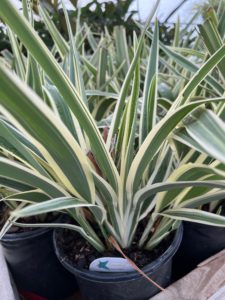
Flax Lily, Variegated Dianella tasmanica
2′ x 2′
Full Sun/Part Sun/Shade
Semi-evergreen. May be damaged in extreme cold. Severe winters may kill it, depending on exposure. The south/southwest exposure is the most protected.
Brightens up a shady area. Flowers are not showy. Zone 9
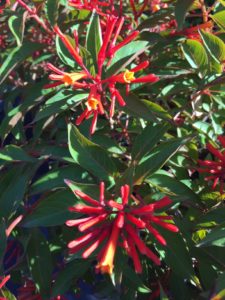
Firebush, Mexican and Lime Sizzler Hamelia patens
Size varies by variety. Species grows to 4′-5′, compact grows to 3′ and Lime Sizzler to 3′-4′.
Sun/Part Sun/Shade Lime Sizzler requires some sun to keep color.
Herbaceous perennial
Attracts hummingbirds. One of the few flowering perennials that tolerates shade. May be killed in severe winters. Zone 8-9
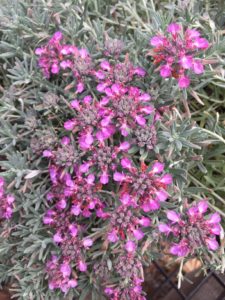
Germander, Creeping Teuchrium chamadrys
6″ x 3′
Sun
Evergreen most winters
Silver foliage with burgundy blooms. Drought resistant once established. Requires well drained soil. Good ground cover for dry areas. Zone 5
 Germander, Silver Bush Teuchrium fruticans
Germander, Silver Bush Teuchrium fruticans
4-6′ x 4′-6′
Full Sun
Evergreen
A good substitute for Texas Sage. Requires well drained soil. May be sheared. Light blue flowers in early summer. The variety ‘Azure’ stays a bit smaller. Zone 8
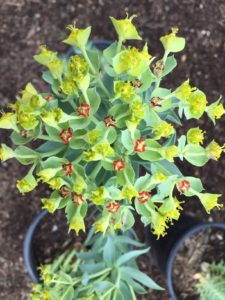
Gopher Plant Euphorbia rigida
2′ x 4′
Sun
Evergreen
Yellow-green flowers appear in February when nothing else is blooming. Blue-green foliage. Plant in well drained soil with other drought tolerant plants. Prune after bloom. Zone 7

Grasses, Assorted Muhlenbergia, Miscanthus, Pennisetum, etc.
Size varies by variety.
Full Sun/some will tolerate partial shade (Gulf Muhly, Mex. Feather Grass)
Herbaceous. Cut back to 4″-6″ in late February/early March
Grasses give form and texture to the landscape. Most have blooms that are attractive. Leave the dormant grasses alone in the winter so you can enjoy the form in the landscape.
Zones vary by variety
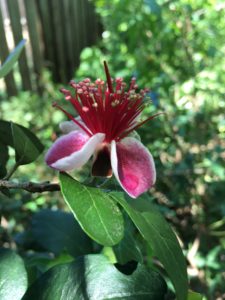
Guava, Pineapple Acca sellowiana
6′-12′ x 4′-8′ may be sheared or grown as small tree
Full Sun/Half Sun
Evergreen
Plants benefit from organic matter in the soil and do very well if soil is slightly acid. Requires well-drained soil. Blue-green leaves. Unusual red and white blooms in the late spring/early summer followed by an edible fruit. Zone 8

Holly, Dwarf Yaupon Ilex vomitoria ‘Nana’
3′-4′ x 3′-4′ Deer tolerant. Deer will browse new growth and keep them “pruned”.
Sun/Half Sun/Shade
Compact growth habit. Since deer browse new growth you may want to spray with Deer Out deer repellant the first few years until it gets to the height you desire. Then the deer will keep it at that height for you! Zone 7
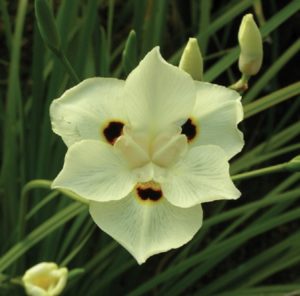
Iris, Bicolor Dietes bicolor
4′ x 4′ Should be divided in late February every 3-5 years.
Sun/Part Sun Does not bloom well in shade.
Semi-evergreen Cut back in late February if winter damaged. Zone8b
Photo courtesy of Greenleaf Nursery
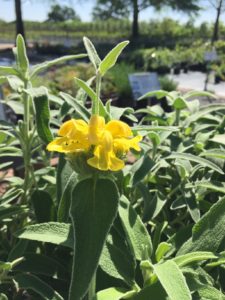
Jerusalem Sage Phlomis fruticosa
4′ x 4′
Sun
Evergreen
Deadhead blooms after flowering. Watch for mealybugs and treat early. Requires well-drained soil. Zone 8

Juniper, Blue Point Juniperus chinensis ‘Blue Point’
12′ x 8′
Full Sun
Evergreen
Nice small juniper for anchoring a landscape. Watch for spider mites and treat in February. Deer may browse when young. Zone 4a
Juniper, Green Mound Juniperus procumbens ‘Nana’
1′ x 6′
Full Sun
Evergreen
Nice evergreen ground cover that looks great under deciduous Crape Myrtles. Zone 4

Juniper, Taylor Juniperus virginiana ‘Taylor’
30′ x 3′
Full Sun
Evergreen, fast growing
A replacement for Italian Cypress. Watch for spider mites and treat in February if found. Zone 3

Lamb’s Ears Stachys byzantina
1.5′ x 3′
Full Sun/Half Sun
Herbaceous perennial
Lamb’s Ear seems to “travel” in the garden. It will come up in slightly different locations each spring. Must have well-drained soils. Remove spent flowers after bloom. Zone 4
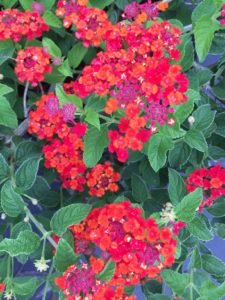
Lantana Lantana spp.
size varies by variety
Sun, at least 6 hours preferred
Herbaceous perennial or annual, depending on variety.
Cut back perennial varieties to 6″ in late Feb./early March (Dallas Red, New Gold, Chapel Hill and Texas) Bandana series is annual here.
Zone depends on variety. Many varieties are annuals in Zone 8, so do your homework!
 Lavender Lavandula spp.
Lavender Lavandula spp.
Size varies by variety
Sun, at least 6 hours
Evergreen perennial. May be pruned after bloom or late Feb./early March. Considered a 3-5 year perennial. Best varieties here are Hidcote or Munstead. Requires well-drained soil. Zone varies by variety.
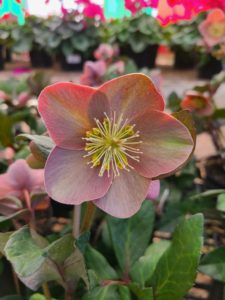
Lenten Rose Hellebore Helleborus x hybrida
Size varies by variety
Shade, dappled shade. Great for a “dry shade” area.
Blooms appear in the winter. Some new varieties have been bred to hold the flowers higher above the foliage. Plant in improved organic soil that is well-drained. Zone 5
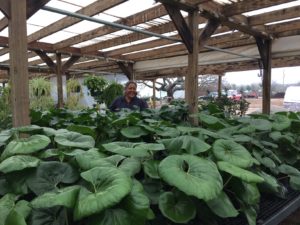 Leopard Plant, Giant Farfugium japonicum
Leopard Plant, Giant Farfugium japonicum
3′ x 3′
Shade/Dappled Shade They do not tolerate sun.
Evergreen to semi-evergreen perennial
Yellow blooms appear late spring. Large “tractor seat” leaves give this plant a tropical look. Zone 7
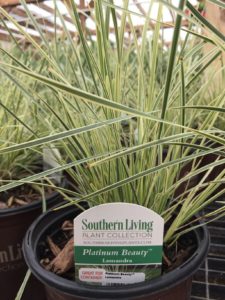
Lomandra, Platinum Beauty Lomandra longifolia
2′ x 3′
Sun/Part Sun
Evergreen to herbaceous
Variegated foliage gives contrast to the landscape. Zone 8
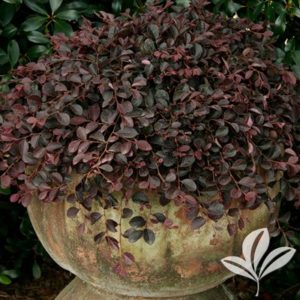 Loropetalum Loropetalum spp.
Loropetalum Loropetalum spp.
size varies by variety
Part Sun Morning sun/afternoon shade preferred, but can take full sun in good soil with regular irrigation.
Evergreen
Flowers appear in February when other plants are not in bloom. Require improved soil, preferably on the acidic side. May be chlorotic in poor soils. May be sheared to shape but have a nice form if not sheared. Zone 7
Photo courtesy of Greenleaf Nursery.
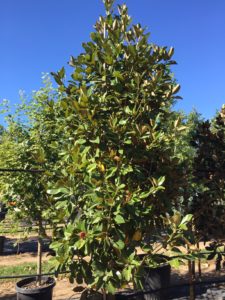
Magnolia Magnolia spp.
size varies by variety. ‘Little Gem’ grows to 20′ x 8′ while DD Blanchard can grow to 50′ x 40′
Sun
Evergreen
Little Gem flowers from spring to fall while the larger Southern Magnolias bloom only in the spring. Most roots are close to the surface of the soil and extend far out from the tree. Do not dig or plant under Magnolias if it will disturb the roots. Zone 6
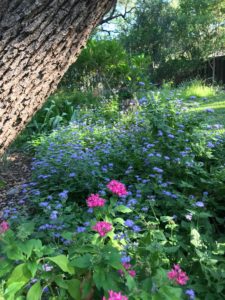
Mistflower, Blue Shade Conoclinium coelestinum
1′ x 6′ spreads in good soil
Shade/Dappled shade
Herbaceous perennial
Does best in improved organic soil. Will spread far if in a moist location. Requires regular irrigation. Butterflies flock to the late summer and fall blooms. Zone 5

Mistflower, Gregg’s Blue Conoclinium greggii
2′ x 6′ Will spread in good soil-give it room!
Sun/Part Sun
Herbaceous perennial
This mistflower blooms from spring to frost, attracting hoards of butterflies to its blue ageratum-like blooms. Zone 7a
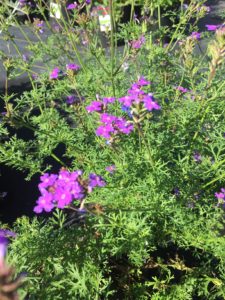
Moss Verbena Glandularia pulchella
8″ x 2′-3′
Sun
Herbaceous perennial
The native verbenas are more reliably deer resistant than the hybrids. The deer may browse when it is young, so use repellant for 2-3 weeks after planting. Zone 8
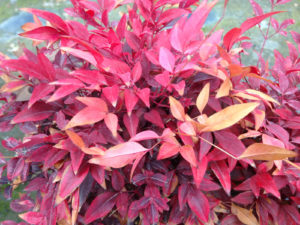 Nandina Nandina spp.
Nandina Nandina spp.
size varies by variety. Nandina domestica and N. domestica compacta are considered invasive because the flowers produce red-orange berries that birds spread into native areas. Dwarf varieties do not flower or produce berries but can spread by their root systems.
Sun/Part Sun/Shade
Evergreen
Useful shrub but contain roots and/or cut off blooms to prevent spread. Fall-winter color can be bright red if planted in the sun. Zone 6
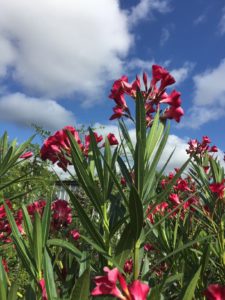 Oleander Nerium oleander ‘Hardy Red’
Oleander Nerium oleander ‘Hardy Red’
8′-10′ x 8-10′ Hardy Red Oleander
Sun
Evergreen to herbaceous. Cut back in late Feb-early March if cold damaged.
All parts are toxic to humans and pets. Drought resistant once established. Plant in low numbers as the bacterial disease Xyllella has taken out large populations in our area. Do not plant entire fence lines with any one species for this reason.
Zone 8-11 depending on variety. Only Hardy Red and Hardy Pink are Zone 8. Some Zone 9 species can survive if planted in S-SW exposure.
 Orange Zest Cestrum Cestrum aurantiancum ‘OZ’
Orange Zest Cestrum Cestrum aurantiancum ‘OZ’
6′ x 6′
Sun/Part Sun
Semi-evergreen to herbaceous Cut back to the ground late Feb-early March for fresh growth in the spring.
Orange-yellow blooms from spring to frost. Reliably deer resistant. Zone 8
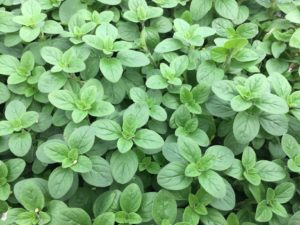 Oregano, Italian or Greek Origanum spp.
Oregano, Italian or Greek Origanum spp.
1′ x 3′
Sun, at least 6 hours
Evergreen
Many of us overlook the herbs in our landscape plantings. Oregano, thyme and rosemary can be grown successfully in deer-populated areas. You may need to use repellant at first, especially on Sage, but after they are established the deer should leave them alone. Zone 5

Oregano, Mexican Poliomintha longiflora
4′ x 4′ Deer will browse the new growth and and keep them “pruned”, so they may not get as large as 4′. Use repellant after planting for at least 3 weeks.
Sun
Evergreen, pink flowers in the summer. Attracts pollinators. May be used as an oregano substitute and is used in Mexican cooking. Zone 7b
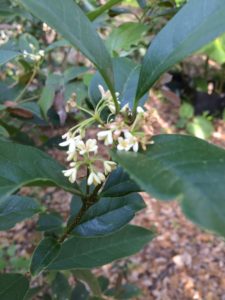
Osmanthus, Sweet Olive Osmanthus fragrans
10′ x 6′-8′
Evergreen
Fragrant white flowers appear sporadically almost year-round. May be sheared. Perhaps not the prettiest shrub, but the fragrant flowers make up for it. Zone 7
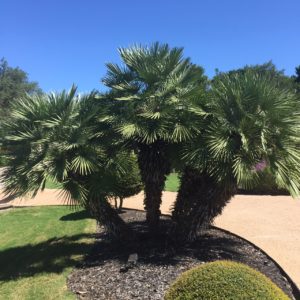
Palm, Mediterranean Fan Chamaerops humilis
8′-10′ x 15′
Sun
Evergreen
This multi-trunk fan palm needs room to grow. It can provide a focal point or perform as screening. Zone 8

Palm, Sago Cycas revoluta
6′-8′ x 6′-8′
Sun/Part Sun
May be evergreen in mild winter.
Not a true palm, but a cycad, this marginally winter-hardy plant may take a “hit” in a severe winter. It rarely reaches mature height because of this.
Zone 8 This is the northernmost part of this plant’s winter hardiness zone.
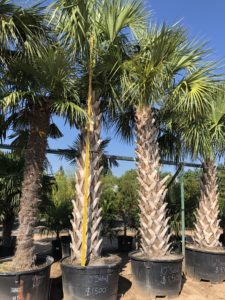 Palm, Florida Sabal Sabal palmetto
Palm, Florida Sabal Sabal palmetto
Palm, Texas Sabal Sabal texana/mexicana
35′-50′ x 20′ wide at top, Florida Sabal may grow to 70′
Full Sun
Evergreen Slow growing
These are some of the most winter-hardy palms for our area. The petioles on the leaves are toothless, unlike the non winter-hardy Mexican Fan Palm, Washingtonia robusta, which has large spines.
Zone 7
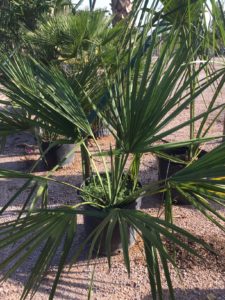
Palm, Dwarf Palmetto Sabal minor
up to 7′ tall and 7′ wide
Sun/Part Sun/Shade
Evergreen
This is our native palm that is often found understory near creek beds. It is a stemless, slow growing palm and is quite winter hardy. Zone 7
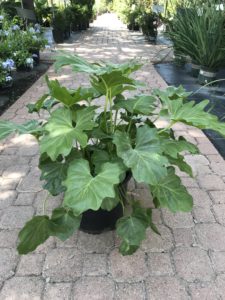
Philodendron, Splitleaf Philodendron selloum
8′ x 8′
Shade/Dappled Shade
Tropical plant. Use in pot under trees and protect in the winter. May survive in the ground if planted on a protected southeast exposure.
Zone 8b
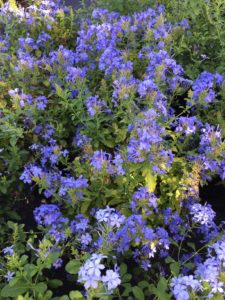
Plumbago, Blue Plumbago auriculata
3′-4′ x 3′-4′
Sun/Part Sun/Dappled Shade
Herbaceous perennial
Cut back to the ground late Feb/early March. Will come back most winters. Plant in protected location if possible and mulch roots in the winter. Zone 8
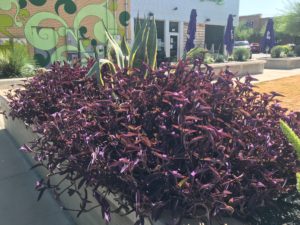 Purple Heart Tradescantia pallida ‘Purpurea’
Purple Heart Tradescantia pallida ‘Purpurea’
12″ x 3’+ Fast growing ground cover
Sun/Part Sun Plant must have sun to keep purple color
Herbaceous perennial
Plant this purple-leaved beauty with pink flowers where you need a bright spot in the garden. Native to the gulf coast of Mexico. Zone 6
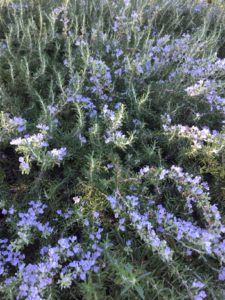 Rosemary, Upright 5′ x 3′ Rosmarinus officinalis
Rosemary, Upright 5′ x 3′ Rosmarinus officinalis
Rosemary, Trailing 1.5′ x 10’+
Sun, at least 6 hours
Evergreen
Upright Rosemary is more winter-hardy than the Trailing, but most will survive for 10-15 years in the landscape. Only trim into the green new growth, as the woody growth does not have the capability of sending out new shoots.
Zone 8 The upright varieties Arp and Hill Hardy are rated Zone 7

Russian Sage Perovskia atriplicifolia
4′ x 4′ Dwarf varieties are available that only reach 1′-2′ tall
Sun, 6 hours minimum
Herbaceous perennial
Cut back to the ground in late Feb/early March. Returns from roots nicely. Gives an “upright” form to the landscape with blue-gray leaves.
Zone 5
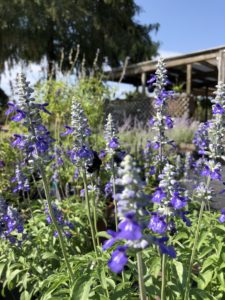
Sage, ‘Henry Duelberg’ Salvia x farinacea ‘Henry Duelberg’
3′ x 3′
Sun/Part Sun, at least 6 hours of direct sun
Herbaceous perennial
Cut back to the ground in late Feb/early March. Comes back reliably in the spring.
Zone 7
 Sage, Mealy Blue or Mealy Cup Salvia farinacea
Sage, Mealy Blue or Mealy Cup Salvia farinacea
1/5′ x 1/5′
Full Sun
Herbaceous perennial
Cut back the the ground in late Feb/early March. Come back fairly reliably in the spring. Requires well-drained soil
Zone 7
Sage, Mexican Bush Salvia leucantha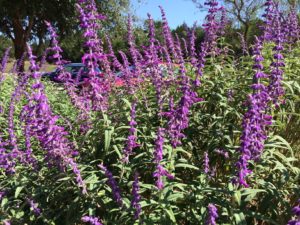
3′-5′ x 3′-5′ Dwarf variety, Santa Barbara, only reaches 2.5′ tall and wide
Sun/Part Sun At least 6 hours is recommended
Herbaceous perennial
Cut back to the ground in late Feb/early March. May flower in spring, but main bloom period is late summer to fall. Plant with Copper Canyon Daisy and Gulf Muhly for a plethora of fall blooms! Zone 7b
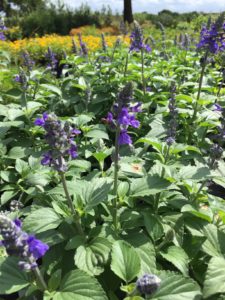
Sage, Mystic Spires Salvia longispicata x farinacea
3′ x 3′
Sun/Part Sun tolerates more shade than many Salvias, but should receive 4-6 hours for best bloom
Herbaceous perennial
Cut back to the ground in late Feb/early March. Comes back reliably most years. Attracts butterflies and hummingbirds. Zone 7
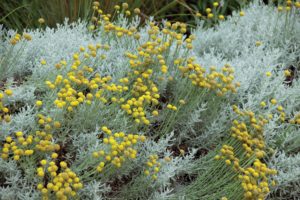 Santolina, Green or Gray Santolina chamaecyparissus
Santolina, Green or Gray Santolina chamaecyparissus
1′ x 3′
Sun Evergreen perennial
Also known as Lavender Cotton, this plant forms a low mound that may drape over a wall if it is planted close enough. Yellow flowers appear for a short time in the summer. Interesting fragrance. Zone 6
Photo courtesy of Greenleaf Nursery
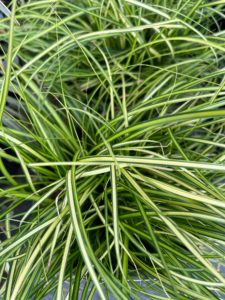
Sedge, assorted Carex spp.
Height varies by variety
Part Sun Two to four hours of direct sun.
Evergreen
These low-growing clumps make a good substitute for lawns.
Zones 4-7, depending on variety
 Senna, Common Tree Cassia corymbosa
Senna, Common Tree Cassia corymbosa
6′-8′ x 6′
Sun/Part Sun At least 6 hours of direct sun.
Evergreen to semi-evergreen shrub, depending on the winter.
Plant in well-drained soil. Yellow flowers in the summer.
Zone 8b

Skullcap, Pink Scuttelaria suffrutescens
1′ x 3′
Sun At least 6 hours of direct sun for best flowering.
Evergreen perennial
May be pruned by “pony-tailing” the growth and cutting into the green growth. Do not cut into woody growth, as it will not flush out.
Zone 7
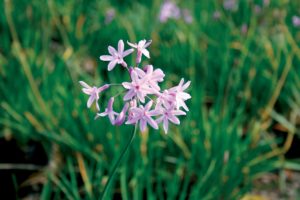 Society Garlic Tulbagia violacea
Society Garlic Tulbagia violacea
1′ x 1′
Sun At least 6 hours of direct sun.
Evergreen most winters.
Do not plant by front door or any entrance as they have an odor reminiscent of skunk! Zone 7
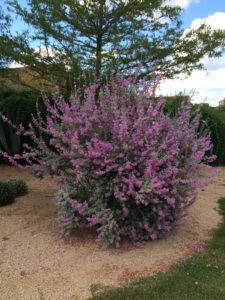
Texas Sage Leucophyllum frutescens, Leucophyllum laevegatum, Leucophyllum zygophyllum, etc.
Size varies by variety. Desperado Sage reaches 8′ x 4′, Green Cloud 8′-12′ x 6′. Lynn’s Legacy only reaches 4′-5′ x 4′-5′.
Evergreen shrub
Texas Sage may be pruned during the growing season into the new growth. Do not prune back into woody growth unless it is in late Feb./early March as it will not flush. Plants bloom before it rains in the summer. Zone varies by variety
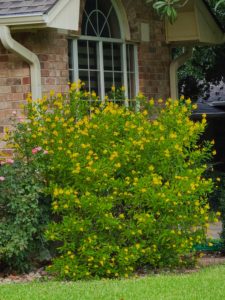
Thryallis Galphimia glauca
6′ x 6′
Sun/Part Sun At least 6 hours of sun is recommended
Evergreen most winters. May have dieback some winters.
What a funny common name for this pretty shrub! It’s almost impossible to pronounce! Spray new foliage twice a week for 3 weeks or so after planting. It is pretty reliable after it is established. Zone 8b
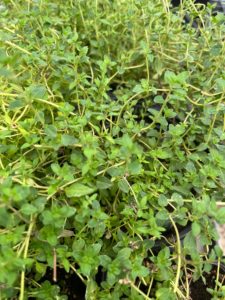 Thyme Thymus spp.
Thyme Thymus spp.
Size varies by variety. Most stay below 6″ and spread about 12″-18″.
Sun/Part Sun
Evergreen
Avoid the temptation to plant in narrow spaces between pavers in full sun. It’s really too hot here to be successful. Morning sun/afternoon shade works, and it makes a nice ground cover in those conditions. Zone4
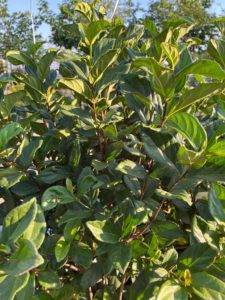
Viburnum, Sandankwa Viburnum suspensum
6′-8′ x 4′-5′
Sun/Part Sun/Shade
Evergreen
This large shrub requires regular irrigation. It requires less frequent irrigation when planted in the shade. Adapts well to shearing. Do not allow mulch to touch the trunks. Zone 8

Vinca major (green or variegated) Vinca major
1′ x 4′ groundcover
Shade
Evergreen (Variegated form pictured)
Considered invasive in some areas. Periwinkle-colored flowers in mid-spring. Watch for a caterpillar known as a “leaf tier” in the summer months and treat with Bt to prevent defoliation. Zone 7
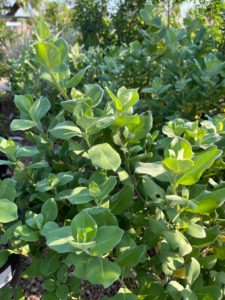
Vitex, Beach Vitex rotundifolia
2′ x 6’+
Sun/Part Sun
Deciduous woody shrub
This beach dweller from Asia is considered invasive in some coastal states, but not in Central Texas. Small blue flowers appear sporadically throughout the summer. Plant in well-drained soil and regular irrigation. Prune back in late winter to control growth. Zone7
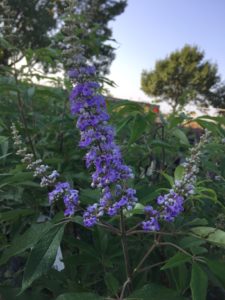 Vitex-Chaste Tree Vitex agnus-castus
Vitex-Chaste Tree Vitex agnus-castus
15′-25′ x 15′-25′ Dwarf forms available that are sterile. One is ‘Flip Side’ Vitex that only grows to 8′ x 8′
Full Sun
Deciduous small tree
This tree is considered invasive in some areas of Texas, but not all. Check with your local extension office to see if your area is one of them. Plant the sterile dwarf variety if it is. Give this tree room, it can get 25′ wide! Purple flower spikes in early summer with repeat blooms in about six weeks unless deadheaded. Also called “Texas Lilac” but the blooms go up-they do not hang down like the northern Lilacs. Zone 6
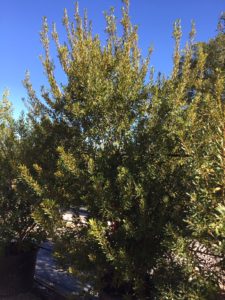 Wax Myrtle, Southern Morella cerifera
Wax Myrtle, Southern Morella cerifera
15′ x 8′
Sun/Part Sun Does not grow well in the shade. Provide at least 6 hours of sun.
Evergreen
Native to east Texas where the soil is better and rainfall plentiful, this large shrub/small tree should be planted where it will receive regular irrigation. It is less picky about soils. Wax Myrtles are easily sheared to keep them full and to control size. Zone7

Wooly Butterfly Bush Buddleia marrubifolia
Sun
4′ x 4′
Evergreen shrub
Plant this silver-leaved drought resistant plant in full sun and well-drained soil. Orange marble-shaped blooms occur in spring and summer. The blooms aren’t very showy, but they attract the butterflies! Little pruning is needed on this compact shrub. Zone 8
Wooly Stemodia Stemodia tomentosa
8″ x 5’+ This low growing ground cover roots at the nodes as it grows, so give it room.
Sun
Semi-evergreen May die back in cold winters but usually returns from the roots.
Plant this fast growing ground cover in full sun and well-drained soil. It is fairly drought resistant once established. The silver-gray foliage produces light blue flowers sporadically throughout the summer. Zone 8a
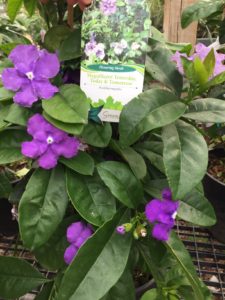 Yesterday, Today and Tomorrow Brunfelsia pauciflora
Yesterday, Today and Tomorrow Brunfelsia pauciflora
3′-5′ x 2′-4′ Compact varieties are available
Dappled Shade
Evergreen shrub
Named for the flowers that open dark purple then turn lavender then white as they age. Main bloom is in the spring, but may rebloom under the right conditions. Plant in fertile soil amended with peat moss to increase acidity. Provide regular irrigation and fertilize with Azalea fertilizer. Zone 9 Plant in a S-SW location to protect from winter winds. Use as an understory plant.
Japanese Yew, Upright Podocarpus macrophyllus
15′-20′ x 3′-4′ Slow growing
Sun/Part Sun/Shade
Evergreen
Shrubby Japanese Yew, Podocarpus macrophyllus ‘Maki’ is often found in the trade and only reaches 8′-10′ x 3′-4′ in 10 years. Both forms require well-drained soil and will not tolerate wet feet. Easily trimmed to keep compact. Deer may browse in some areas. Zone 8

Yucca species
Size varies by variety
Most require full sun. Softleaf Yucca, Yucca pendula, will tolerate some shade.
Plant yucca in well drained soil. Watch for the Agave weevil, as it will attack some species of yucca. Treat Yucca plant bugs as soon as they are noticed to avoid unsightly damage.
Zone varies by variety Beaked Yucca (shown) Yucca rostrata is quite winter hardy in Central TX.

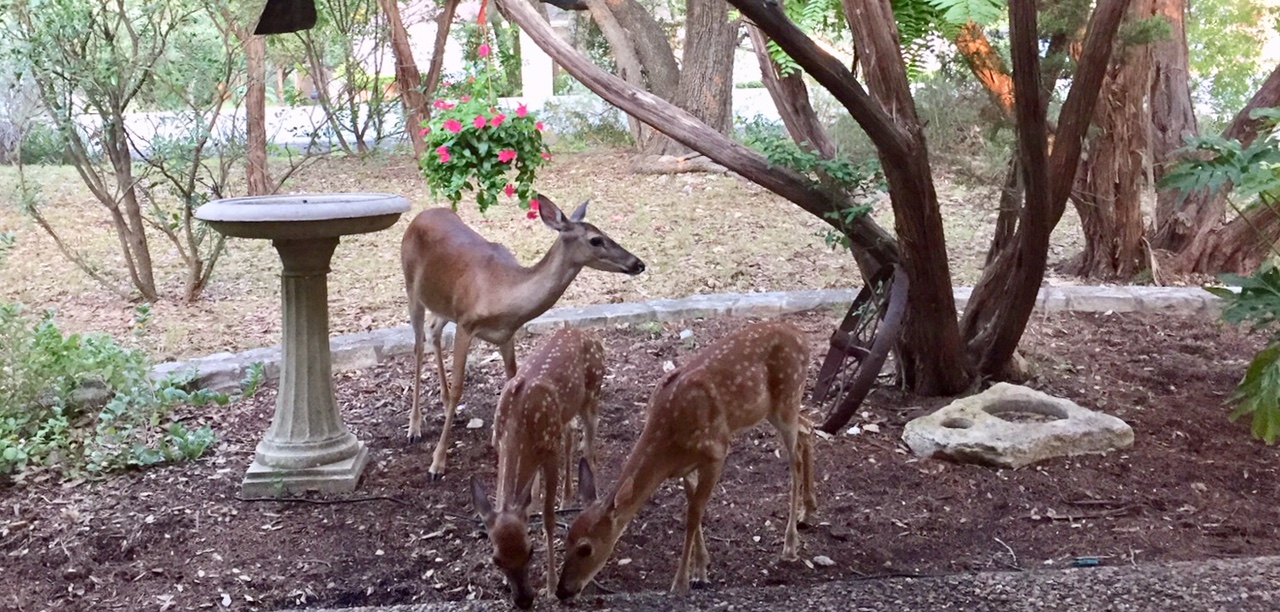


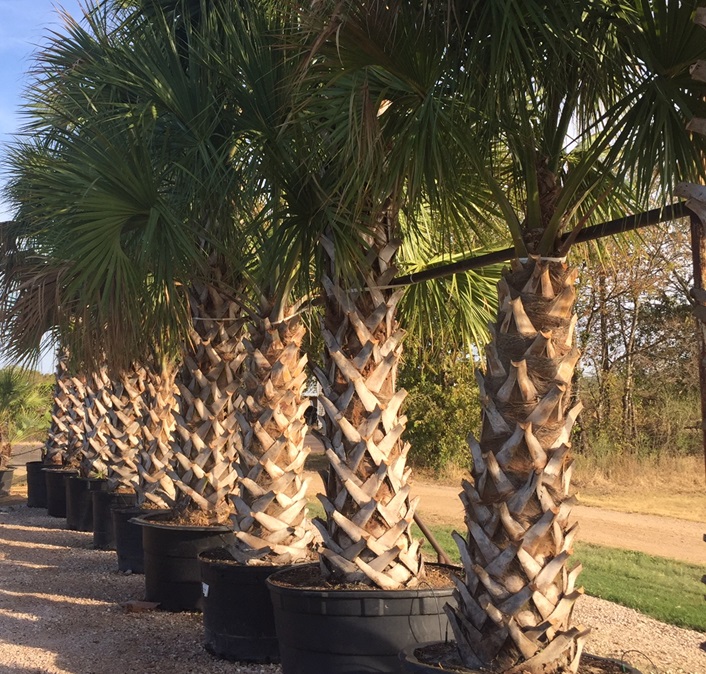
Leave A Comment